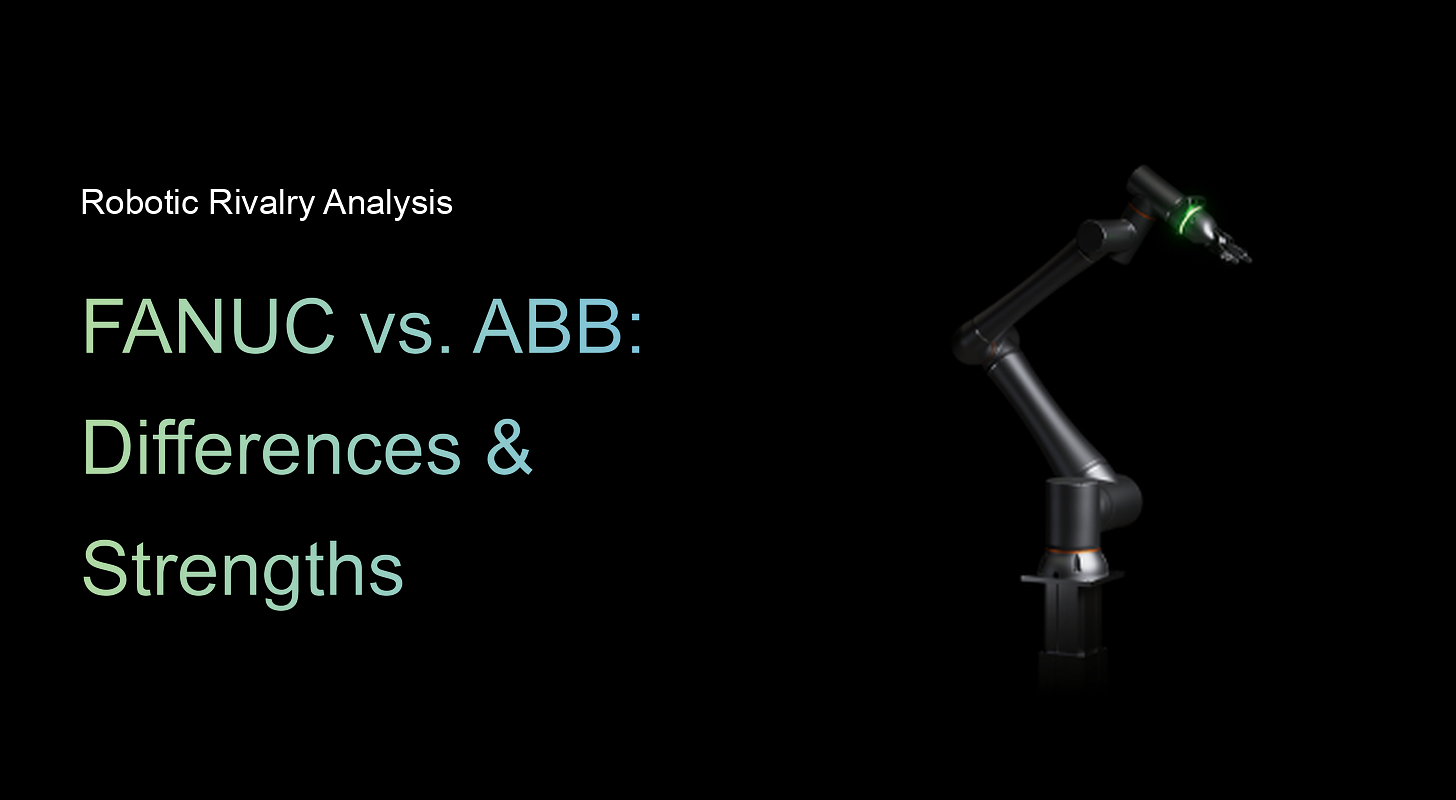FANUC in 2025 is one of the most recognized names in industrial automation, with over 1 million FANUC robots installed worldwide in 2023.
The company’s range spans from precise pick-and-place delta robots to heavy-payload arms capable of moving the entire car chassis. FANUC robot pricing ranges from around $40,000 to $400,000+, depending on the model.
Businesses in automotive, electronics, packaging, and manufacturing often achieve a return on investment within 12 to 36 months, thanks to FANUC’s speed, durability, and global service network.
What are FANUC robots?
FANUC robots are industrial robots manufactured by FANUC Corporation, a global leader in factory automation. These robots are known for their reliability, precision, and wide range of applications in various industries.
The company manufactures a wide range of robots, from small-payload articulated arms to some of the largest six-axis robots in the world, capable of lifting over 2,000 kg.
Founded in 1956, FANUC has grown into a global automation leader, with manufacturing facilities in Japan and the USA. FANUC serves industries including automotive, electronics, packaging, aerospace, and food processing, offering solutions that balance speed, durability, and integration flexibility.
Exploring FANUC’s robot lineup includes:
- Industrial 6-axis robots: These articulated arms are the backbone of FANUC’s offering, with payloads starting at just a few kilograms and scaling to over 2,300 kg. They’re used for welding in automotive plants, palletizing heavy loads, CNC machine tending, and precise assembly tasks.
- SCARA and delta robots: FANUC SCARA models deliver rapid, repeatable motion for assembly, inspection, and packaging in electronics, medical device, and consumer goods production. Delta pickers like the M-2iA operate at high speeds for sorting, picking, and placing lightweight products, especially in food and pharma packaging.
- Cobots: The CR and CRX series allow safe human-robot interaction, with force-limited joints and intuitive programming. They’re often deployed for assembly, inspection, and loading/unloading without the need for full safety fencing.
- Specialty robots: FANUC produces dedicated models for painting, cleanroom environments, and food-grade handling, with corrosion-resistant finishes, sealed housings, and compliance with hygiene standards.
- FANUC RoboDrill automation: When integrated with FANUC robots, RoboDrill CNC machines become complete automated cells, capable of continuous operation with minimal human intervention.
FANUC models worth knowing in 2025
FANUC’s 2025 lineup includes robots for every scale and application, from compact cobots to high-payload industrial arms.
FANUC CRX-10iA/L
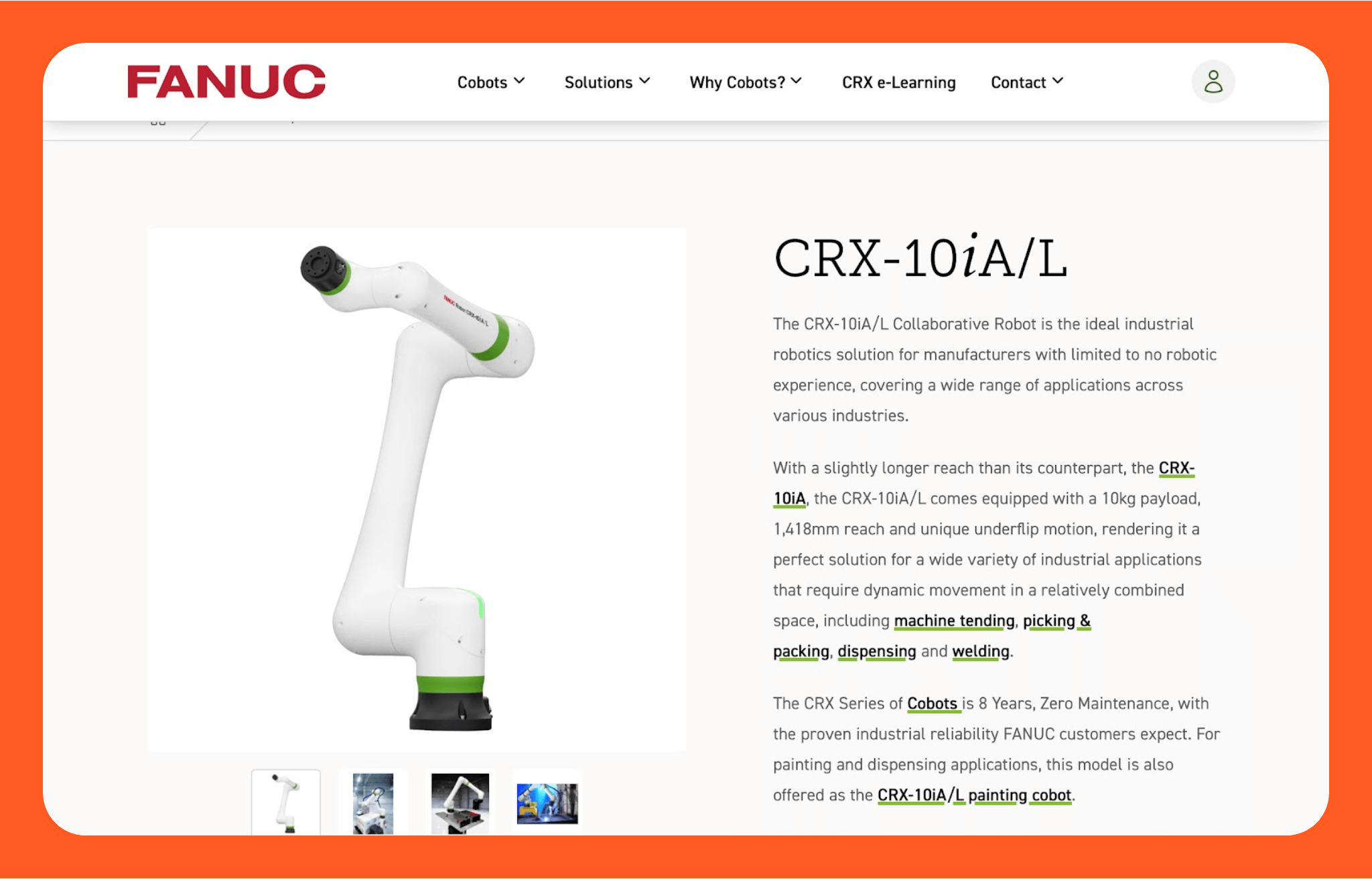
The FANUC CRX-10iA/L is a cobot designed for safe operation alongside human workers, eliminating the need for extensive safety fencing in most setups. It offers a 10 kg payload and an extended reach of 1418 mm, making it well-suited for applications like machine tending, assembly, inspection, and packaging.
Its lightweight build allows flexible mounting options: floor, wall, or ceiling, so it can adapt to different workspace layouts.
Programming is simplified through drag-and-drop interfaces and tablet-style controls, reducing training time for operators. The CRX series is IP67-rated for dust and liquid resistance, enabling reliable use in environments where exposure to fluids or fine particles is common.
FANUC LR Mate 200iD
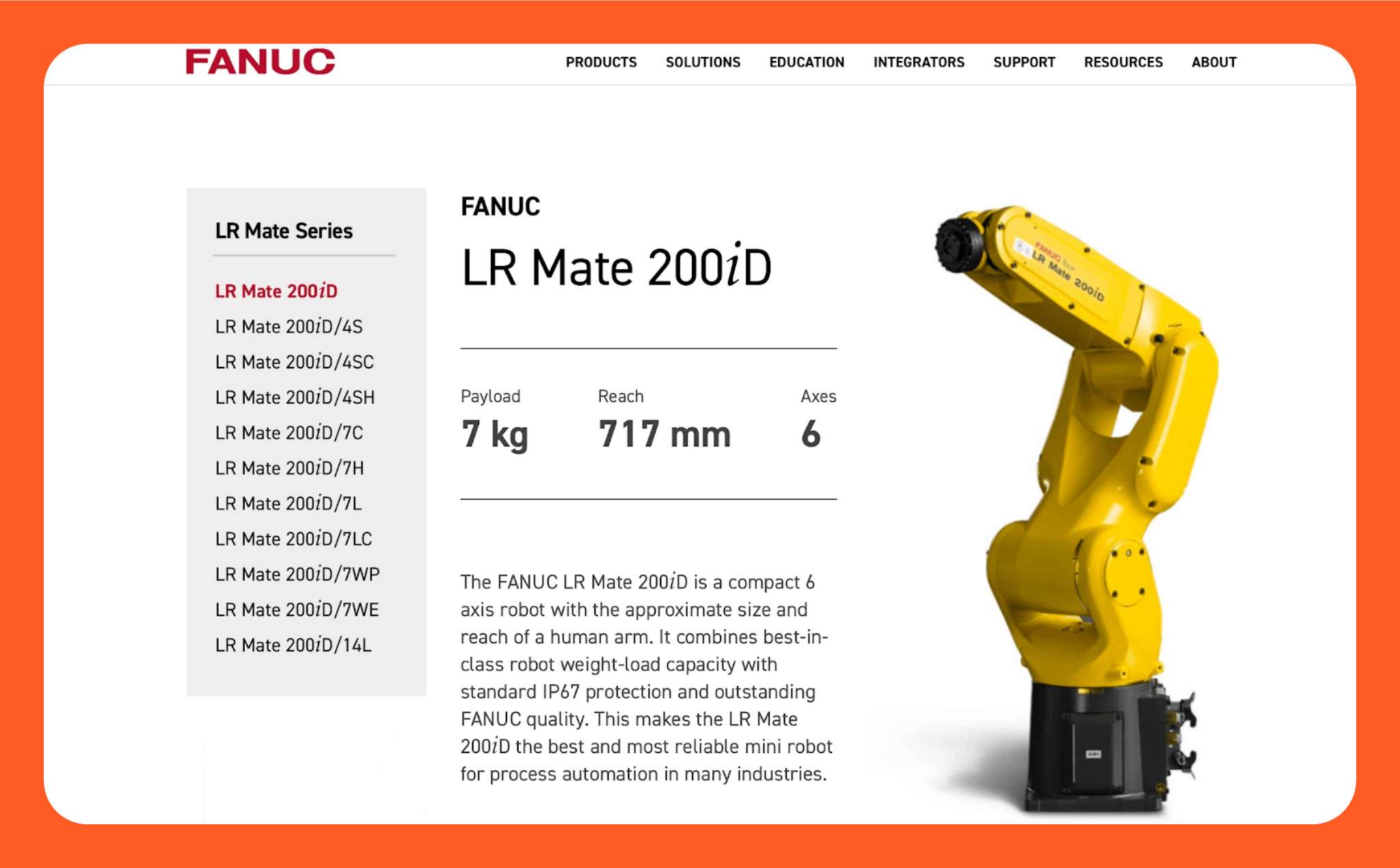
The FANUC LR Mate 200iD is a compact six-axis industrial robot designed for precision work in tight spaces. Comparable in size to a human arm, it’s ideal for assembly, machine tending, packaging, and inspection tasks where accuracy and repeatability matter.
The 200iD series offers multiple variants, including clean room-rated, wash-proof, and high-speed models, with payload capacities up to 7 kg and reach options from 717 mm to 911 mm.
Its slim profile allows installation directly into production lines or inside small machines, while its sealed joints and optional IP67 protection ensure durability in dusty or wet environments.
The LR Mate 200iD supports FANUC’s full range of vision systems, enabling applications such as part orientation and quality control.
FANUC M-20iD series
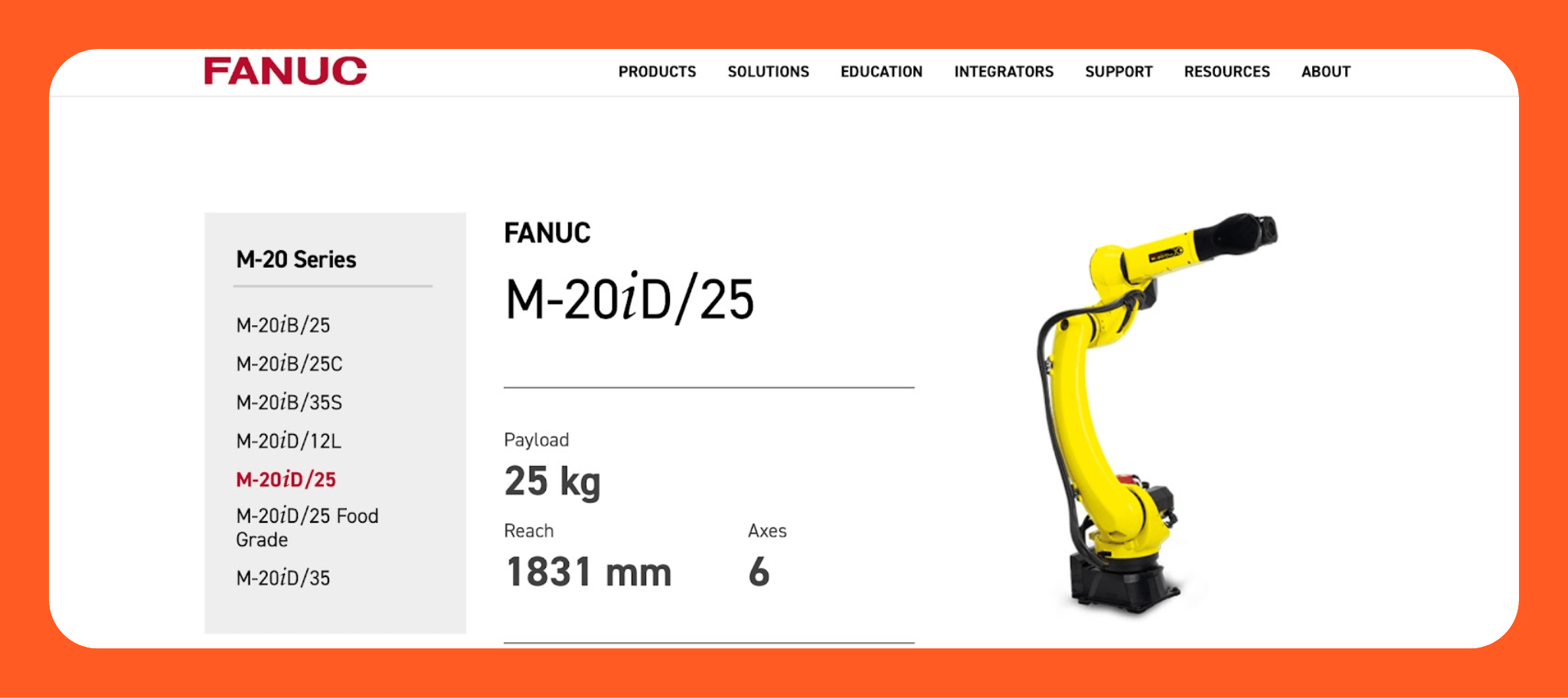
The FANUC M-20iD series is a versatile line of six-axis industrial robots built for high-speed handling, assembly, and general manufacturing tasks. Models in this series, such as the M-20iD/25 and M-20iD/35, offer payload capacities of 25 kg and 35 kg, respectively, with reach options up to 1,831 mm.
This makes them suitable for loading heavy components, palletizing, and multi-part assembly in industries ranging from automotive to consumer electronics.
The M-20iD features an enclosed design with internal cable routing through the arm, wrist, and body to protect hoses and wires from wear. This reduces maintenance needs and extends service life, even in high-duty-cycle environments.
Its slim arm design allows access to tight machine spaces, while repeatability of ±0.02 mm ensures consistent accuracy for precision work.
With compatibility for FANUC’s iRVision system and advanced motion control, the M-20iD can be adapted for both simple handling and complex automation tasks.
FANUC M-2iA delta picker
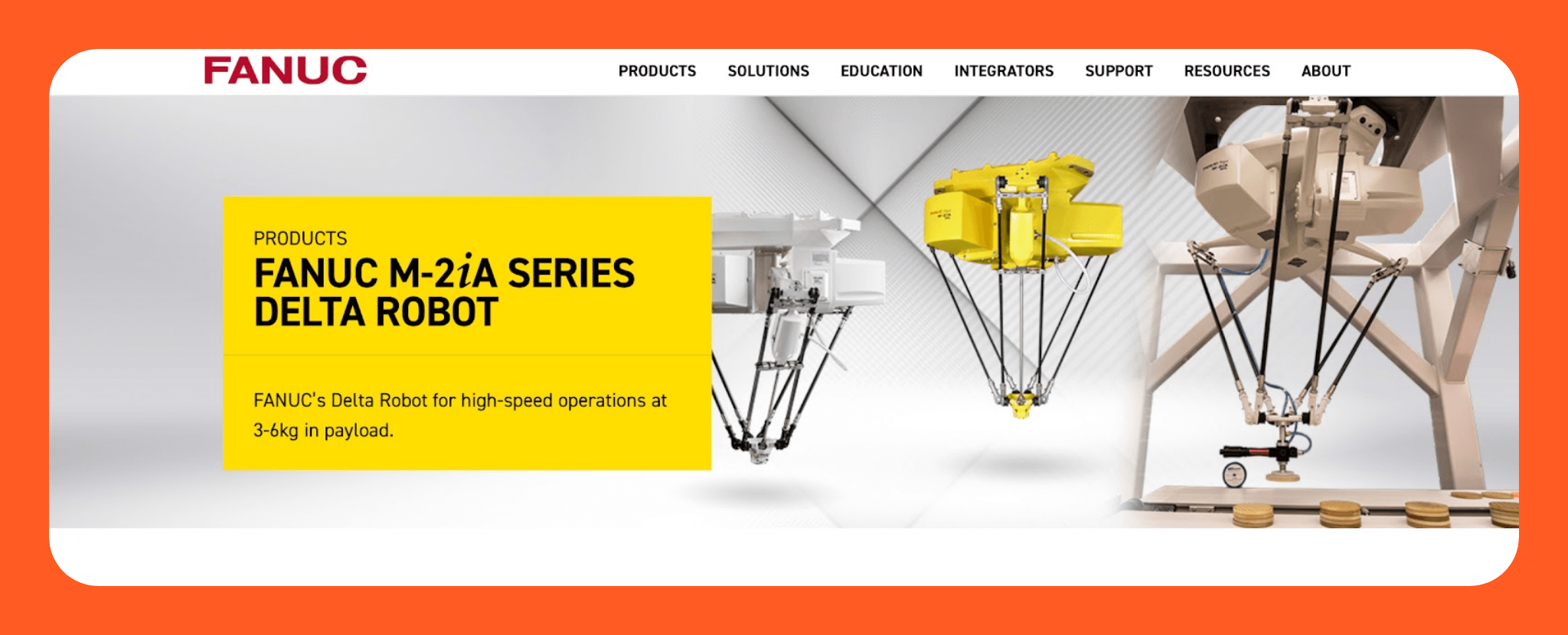
The FANUC M-2iA is a high-speed delta robot designed for ultra-fast pick-and-place operations in industries like food processing, electronics, and pharmaceuticals. With speeds of 150 to 182 picks per minute, it’s optimized for handling lightweight items weighing up to 6 kg.
Available in 800 mm and 1130 mm configurations, the M-2iA can adapt to both small and large work envelopes.
Its parallel-link structure ensures stability and precision, delivering repeatability of ±0.04 mm. The M-2iA is IP69K-rated in certain variants, enabling washdown capability for hygienic applications, including meat, dairy, and packaged goods handling.
Integration with FANUC’s iRVision system allows it to identify, sort, and place items without additional tooling changes.
Common uses include sorting confectionery, placing parts into blister packs, or handling delicate electronics at high throughput rates while maintaining consistent product quality.
FANUC M-2000iA

The FANUC M-2000iA is the heaviest-payload six-axis robot in the company’s lineup, designed for extreme lifting and extended reach applications. Available in models like the M-2000iA/2300, it can handle payloads up to 2,300 kg, which is enough to lift an entire vehicle body in a single motion.
Reach options extend up to 4.7 meters, making it ideal for large part handling, heavy palletizing, and high-volume automotive production.
Its rigid arm construction ensures stability when moving massive loads, and precision motion control maintains accuracy within ±0.1 mm even at maximum payload.
The M-2000iA can replace overhead cranes or manual handling in operations like truck assembly, sheet metal movement, or large mold positioning.
Equipped with sealed joints and internal cable routing, it’s built for 24/7 operation in demanding industrial environments where uptime is critical and part sizes are beyond the capacity of standard robots.
How much do FANUC robots cost?
FANUC robot costs in 2025 vary by model, payload, speed, and integration needs. While official prices aren’t published, the ranges below are based on verified industry and distributor data, with actual costs depending on configuration and region.
Getting started with RoboGuide and programming
Step 1: Set up your virtual environment
Use FANUC RoboGuide to design, test, and refine programs offline. Import CAD models, configure tooling, and simulate cycle times to validate performance. A free 30-day trial is available.
Step 2: Choose your programming method
Program via Teach Pendant (TP) or iPendant Touch. Beginners can record and replay movements without coding, while advanced users apply TP programming for custom logic.
Step 3: Add vision capabilities
Integrate iRVision for automated part detection and flexible positioning.
Step 4: Deploy to the robot
Upload tested RoboGuide programs directly to avoid trial-and-error on live equipment.
Where FANUC robots excel
FANUC robots are built for applications that demand precision, speed, and uptime. FANUC consistently outperforms in high-volume automotive welding to delicate electronics assembly and heavy-duty material handling in logistics and manufacturing.
Key areas where FANUC robots deliver strong results include:
- Material handling: From palletizing heavy goods to transferring small electronic parts, FANUC arms handle precise, repetitive lifting with minimal downtime. High-payload models like the M-2000iA replace overhead cranes, and smaller units such as the LR Mate 200iD are used for bin picking and conveyor loading.
- Welding automation: In automotive and heavy fabrication, FANUC six-axis robots integrate with MIG, TIG, and spot-welding setups. Their repeatable motion ensures consistent weld quality and reduced rework.
- Assembly: Compact models like the LR Mate series perform high-speed assembly of electronics, medical devices, and consumer products. FANUC’s motion control and vision systems allow for delicate handling without damaging components.
- Pick-and-place: Delta robots like the M-2iA achieve speeds over 100 picks per minute in packaging, food, and pharmaceutical operations, maintaining product integrity through precise handling.
- Machine tending: Models such as the CRX-10iA/L work with CNC machines to load and unload parts, often without fencing.
- Painting and coating: FANUC paint robots are engineered for uniform coating in automotive and consumer goods manufacturing, with explosion-proof variants for volatile environments.
Challenges to keep in mind
While FANUC robots deliver proven performance, certain factors can affect adoption and ROI. This section outlines the main challenges, including upfront cost, programming requirements, and space needs, so you can plan effectively and avoid unexpected hurdles during integration.
- Higher upfront cost: Compared to some competitors, FANUC’s new models can have a steeper initial investment, especially in high-payload or specialized configurations. This can be offset over time by longer service life and lower unplanned downtime.
- Proprietary programming environment: FANUC’s TP language and control interface are reliable but not open-source. Teams without prior FANUC experience may face a learning curve, requiring dedicated training or hiring certified programmers.
- Integration complexity: Adding FANUC robots to complex, multi-vendor production lines can require skilled system integrators, increasing both time and cost before the first part is produced.
- Training and certification costs: FANUC offers official training programs for operators, maintenance staff, and programmers, but these come at an additional expense that should be factored into the total investment.
ROI and payback expectations
For most applications, FANUC robots achieve a return on investment within 12 to 36 months, depending on the workload, cycle time, and production volume.
In high-volume operations such as automotive welding cells or food packaging lines, ROI can be closer to the 12-month mark due to continuous operation and minimal downtime.
In smaller-batch or multi-product facilities, the payback period may extend toward the higher end of the range.
Factors influencing ROI include:
- Labor savings: Replacing repetitive manual work reduces labor costs and frees operators for higher-value tasks.
- Cycle time improvements: High-speed robots like the M-2iA delta picker can dramatically increase throughput, multiplying revenue potential.
- Reduced waste: Precision handling and consistent motion paths minimize product defects and scrap.
- Maintenance and service contracts: Proactive service agreements can prevent costly breakdowns, but their annual cost (typically 5–10% of purchase price) should be included in ROI calculations.
For businesses aiming at predictable, repeatable processes, FANUC robots often provide measurable cost recovery well within three years.
FANUC vs. its biggest rivals
In industrial robotics, FANUC’s main competitors are KUKA, ABB, and newer market entrants like Standard Bots’ RO1. Each brand has its strengths, so the right choice depends on your priorities.
- FANUC: Known for reliability, long service life, and a vast global support network. The brand offers one of the widest ranges of robot types and payload capacities, from small SCARA units to the 2,300 kg M-2000iA. Proprietary controls ensure consistent performance but require brand-specific training.
- KUKA: Favored for flexible architecture and modular design, particularly in European markets. It excels in heavy-payload welding and complex, high-mix manufacturing.
- ABB: Strong in precision machining, painting, and digital integration. Offers advanced simulation tools and broad support for vision-guided tasks.
- Standard Bots: Built for manufacturers seeking high-quality automation without high costs or long lead times. RO1 pairs industrial precision with AI-assisted programming, 3D vision, and cage-free operation. It installs in days, handles varied palletizing and assembly, and costs about half of many comparable cobots.
Summing up
In this guide, we covered FANUC’s top models, pricing, core strengths, and key challenges, along with ROI expectations and comparisons with leading competitors.
FANUC's 2025 lineup spans from compact cobots (CRX-10iA/L) to heavy-duty robots (M-2000iA lifting 2,300 kg), including versatile models like LR Mate 200iD, M-20iD, and high-speed delta pickers (M-2iA). Prices range from $40,000 for entry-level units to $400,000+ for heavy-payload models, with typical ROI in 12–36 months.
Buyers should weigh FANUC's broad range, integration tools (RoboGuide, iRVision), durability, precision, and global support against higher upfront costs, proprietary programming, and training requirements.
Next steps with Standard Bots’ robotic solutions
Looking to upgrade your automation game? Standard Bots’ RO1 is the perfect six-axis cobot addition to any production line, delivering unbeatable precision and flexibility.
- Affordable and adaptable: RO1 costs $37K (list price). Get high-precision automation at half the cost of traditional robots.
- Precision and power: With a repeatability of ±0.025 mm and an 18 kg payload, RO1 handles even the most demanding CNC jobs.
- AI-driven simplicity: Equipped with AI capabilities on par with GPT-4, RO1 integrates smoothly with CNC systems for advanced automation.
- Safety-first design: Machine vision and collision detection mean RO1 works safely alongside human operators.
Schedule your on-site demo with our engineers today and see how RO1 can bring AI-powered greatness to your shop floor.
FAQs
1. What does FANUC stand for, and how did the company start?
FANUC stands for “Fuji Automatic Numerical Control.” The company started in 1956 as part of Fujitsu, developing CNC systems for Japan’s machine tool industry. By the 1970s, FANUC expanded into industrial robotics, becoming a global leader with over one million robots installed across manufacturing, automotive, electronics, and logistics industries.
2. Can I program a FANUC robot without a teach pendant?
Yes, you can program a FANUC robot without a teach pendant by using FANUC’s PC-based software tools, such as RoboGuide or third-party offline programming platforms. These options allow code creation, simulation, and testing on a computer, which can speed up development, reduce wear on hardware, and streamline programming workflows.
3. What is the difference between FANUC CNC controls and FANUC industrial robots?
The difference between FANUC CNC controls and FANUC industrial robots lies in their applications. FANUC CNC controls operate machine tools, automating precision machining processes like milling and turning. FANUC industrial robots handle material movement, welding, painting, and assembly. Both share FANUC’s reliability, but serve different automation roles in manufacturing.
4. How long does it take to learn FANUC robot programming for a beginner?
Learning FANUC robot programming for basic operations can take one to three days with formal training, thanks to intuitive teach pendants and user-friendly interfaces. More advanced tasks, like integrating vision systems or multi-axis coordination, may require one to two weeks of hands-on practice or certified FANUC training courses.
5. Which FANUC robot has the highest payload capacity?
The highest payload capacity FANUC robot in 2025 is the M-2000iA/2300, capable of lifting up to 2,300 kilograms. Designed for heavy-duty applications such as automotive body handling, large metal parts, or entire assemblies, it offers extended reach and robust precision for demanding industrial operations that require extreme lifting strength.
6. Are there free resources to learn FANUC robot programming online?
Yes, there are free resources to learn FANUC robot programming online, including FANUC America’s YouTube tutorials, integrator blogs, and robotics forums. These sources provide valuable tips and demonstrations, but advanced programming and certification still require official FANUC courses to fully master complex applications, safety protocols, and industry-specific programming techniques.
FANUC also offers free online learning modules at fanucworld.com, and RoboDK provides tutorials on offline programming, simulation, and multi-robot setup for all skill levels.
Join thousands of creators
receiving our weekly articles.







.png)


